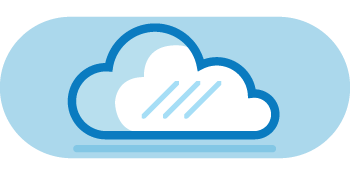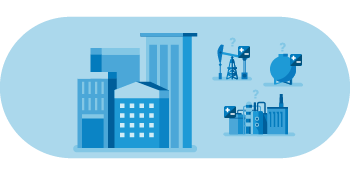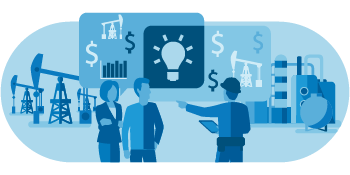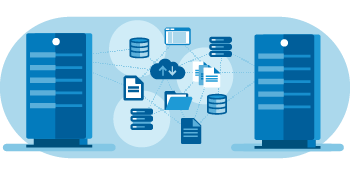Quorum Software Chief Product Officer Tyson Greer participated in the THRIVE Energy Conference presented by Daniel Energy Partners. THRIVE Energy brings together key professionals who collaborate on research-driven insights and trends that are key to developing a pathway to a thriving energy future. Tyson spoke in the panel, “Emerging Oilfield Technology Opportunities,” with Ted Furlong, Chief Data Scientist, Baker Hughes, Maynard Holt, CEO, Tudor, Pickering, Holt & Co, and Bill Austin, Managing Partner, Daniel Energy Partners.
Read on for a partial transcript of the panel discussion or view the recording, courtesy of Daniel Energy Partners. The panelists’ dialogue has been edited for clarity.

Cloud Adoption in Energy
Bill Austin: With technology and energy, we’re always talking about adoption and people getting comfortable and realizing it’s reliable. What can you tell us about the industry’s adoption of the cloud, how comfortable people are with that, and how important that is to everything?
Ted Furlong: The industry is getting increasingly comfortable with the cloud, and that’s true for the big IOCs and some of the NOCs we work with. Not everyone has fully embraced the cloud, but we’re seeing more virtual private clouds contained within countries or operating environments. Increasing confidence in security vulnerability because some of the best practices are within the cloud companies, so you can rely on the security to come through.

Security of the Supply Chain
Maynard Holt: What are the internationalization of data and security supply chain considerations doing to your world?
Ted Furlong: We take our sourcing decisions seriously. Some of the vulnerabilities people have found have certain firmware embedded in a hard drive, recording information and sending it places. We take sourcing very seriously for our products, so we work with our suppliers and check that sort of thing. All the way through our digital supply change, we do check vulnerabilities. In our remote operations, we have world-class security. Does that mean we’re immune to vulnerability? It doesn’t. But going back to the adoption of cloud technology, we are leveraging open source technologies to have multiple eyes looking and ensuring we have the best available technology delivering that security.
Bill Austin: You guys are dealing with large cloud providers, and these aren’t fly-by-night operations. How do you understand vulnerabilities and protect your customers through the supply chain?
Ted Furlong: That’s correct. That’s why it takes good partnerships and good relationships to make sure that you’ve vetted out these vulnerabilities and are addressing them.
Bill Austin: Talk a little about your products. What is something you can help people with?
Tyson Greer: Oil and gas is a diverse discipline that requires a complex system landscape to do what you do. Geophysics, petrophysical workflows, enormous supply chain complexity, tremendous amounts of data, etc. Our view is that through integration, broader capabilities, and the ability to bring data more quickly and seamlessly into decision maker’s hands—they get precision in decision making and the opportunity to run a better business. That’s the driver of business software—am I able to create value.
Maynard Holt: I know Quorum has made a couple of acquisitions and has a strategy to move towards a single platform system, so everything is managed in one place. Where is this headed? What does Quorum look like in 3-4 years?
Tyson Greer: Our perspective is really about return on investment and value. Now, [the Oil & Gas C-suite] has got to deliver integrated value at the highest level, and the only way to do that is through better-integrated systems. Ultimately, our goal is to provide a platform that can solve this challenge. How do I evolve from something highly complex? How do I create a value stream over time that allows me to invest in technology and deliver value to the organization for something that will take me five to ten years to modernize? As a single vendor of scale, we believe that we’ll be able to do that better than anybody else.

Return on Investment in Technology
Maynard Holt: Calculating the returns of tech investment is a major problem and difficult to quantify. How do you address that?
Ted Furlong: Nothing brings better [buy-in] for an organization than when they’re seeing results and getting the value. For example, when we have analytics looking at pump life and helping customers run pumps better, that’s an obvious economic value associated with that improvement. They can all see that. [Proving value of tech investment] is like an insurance sale in the sense that there’s an element of credibility, but change management is the bigger thing. It’s more of a mindset of evolving into a more dynamic software environment.
When they shift from on premise compute and storage to a cloud provider, most people are surprised that it’s more money to be in a cloud environment. The reality is that it is more money to be in a cloud environment. But you get all the other benefits in terms of scalability, simplicity, staying current with the correct version of the software, etc. That SaaS mentality is what will enable the industry to reach new levels of productivity.
Maynard Holt: I’m surprised to hear the cloud would be more expensive. Could you talk more about that?
Ted Furlong: The best analogy I can give you is that I used to buy a roll of film for $5 and print out the pictures and have them forever. Now I spend $5 a month to look at pictures whenever I want online. Is it cheaper? I don’t know. But it is more efficient to use keywords to search for a picture of my daughter riding a horse on the beach, and it shows up instantly, instead of digging through stacks of pictures in the past. There’s value right there.
Bill Austin: How do you prove efficiencies for your customers?
Tyson Greer: It’s cultural. You see operators that push digitization through the entire organization. Some opportunities have hard ROIs in this business; paper is a great example. Oil and gas is a real-estate business. My father is in banking, and we talk about how banking and energy had the last two bastions on Earth with extreme amounts of paper. Digitization and connecting what’s in file cabinets with the ability to have all that information at your fingertips and proximity to all your other digital records is key. Especially in COVID, as people are pushed from their environments, they realized they didn’t have access to any of their files, so that’s an easy way to evolve into your digital strategy that provides immediate ROI to the business.
You have to be creative in finding that value stream. Knowing how to get from point A to point B and bring value to the business by having a roadmap that ensures that all of my decisions bring them closer to their ultimate goal – versus random decisions that get them to digitization but, in the end, they move farther from the end goal because of disparate systems, unintegrated workflow processes, and ultimately leaving them a lot of things digitized but not any more efficient.

Mergers and Acquisitions
Maynard Holt: So if all these mergers and acquisitions happen over two years, do you get excited about that because bigger companies can spend more and do more? Or do you see it as a software analytics mess that’ll slow everything down and hope it doesn’t happen?
Tyson Greer: A lot of technology in oil and gas was created through M&A, but they were doing it to get scale and slamming things together. Now, I see companies looking at things like: are they accretive, can we execute them, are there cultural fits, and can we extract the cost synergies of the business that we need. I think the industry is getting smarter around M&A.
I think it does create challenges for solving this problem on an even grander scale because now you’re putting together two things that you know need modernization themselves. You’re creating another curve to rationalize them. It will create opportunities for the mid-cap and smaller-caps, as people focus on making money in profit. They have an advantage over some of that scale and their ability to modernize and use technology better.
Ted Furlong: A lot of the reasons for going into a cloud environment or SaaS is, if you get into M&A activity, you don’t have a huge software integration cost that can come on the back end. Many people have done ERP integrations, and they can be extremely painful. I’ve done many of those implementations myself, and I think you know what you’re trying to move is to more modular software, different business units that are more modular, etc. Their software can interact, and you want to enable the workforce to be more multi-disciplinary themselves. That’s the part of a lot of these underlying software tools.
Just like we want our rig hands to be able to support different aspects of well construction, we also want our application engineers to be able to support mud programs, BHA selection, trajectory optimization, or pump selection. And so, how can you help your application engineers? How can you drive these workflows and simplify the integration of a lot of its data? How can you bring it all together in a simple way?
Tyson Greer: I agree. Think about a land department. What they needed to do a decade ago, and what they need to do today. The systems and how they’re organized predicate high levels of leasing and activity that they needed ten years ago. Are companies appropriately looking at the software, the process, and the people aspect of who does what and can blur lines and get more efficiency out of every department in the most robust and disruptive way? Companies that do that and rethink the problem for the new normal will be the ones that succeed.

Data Sources and Uses
Maynard Holt: Is anybody doing something new or crazy with data that we have not thought about collecting before? Any trends that surprise you?
Tyson Greer: I don’t think they’re collecting new data sources, but companies are definitely putting it all together, figuring out how to use AI to create high-quality data sets—and oil and gas has a tremendous amount of data. The problem is making sure [the data is of] sufficient quality and integrating it to do things with it. There are some very innovative companies—small, medium, and large—that are doing extreme levels of automation and high levels of decision-making. And then some companies haven’t even begun to embrace it. You see companies all over the map in terms of adoption across the industry.
Ted Furlong: I would say the same. We see more discipline in collecting high-quality data. The surprises now come when people don’t bother to collect data. We’ll finish our project, turn in the data, and the client never looks at it. It still happens, and that surprises us. It’s less and less common. It’s more around having the discipline to load the data in a consumable way because that’s the key. What you don’t want is someone saying that somebody has this file on their laptop; that doesn’t do anyone any good. Can the data be loaded in a format that consumable and find an application that can use it? And is it a click of a button? Because anything harder than that, none of us have time for. So you have to get user experience to the point where it’s easy for people to do multiple jobs, and it drives value.
Bill Austin: We’ve been talking a lot about making decisions off of data. As long as it’s good, you can do something with it.
Tyson Greer: The OSDU is an industry partnership making data universal. It’s an open language to share service and subsurface information across technical systems and business systems. It’s a partnership with many companies in the service, technology, and operator sector in North America and abroad. I think the OSDU is a great example of recognizing that collaboration amongst companies and various departments to create a single source of truth is ultimately the way to win.
Want to learn more about emerging technology trends in oil and gas? We met with Amazon Web Services (AWS) to discuss cloud migration for large and small operators and the benefits of a cloud-based digital strategy. In this webinar, we review the OSDU initiative to transform the industry by standardizing management and access to large volumes of critical data.
 Previous Page
Previous Page